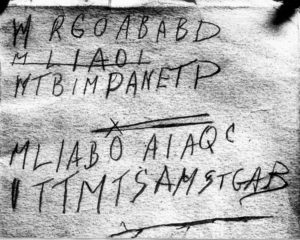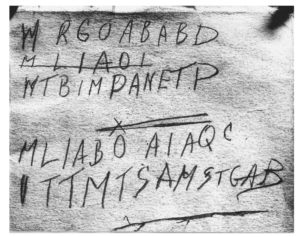Unfortunately, the original copy of the Rubaiyat of Omar Khayyam with the “Tamam Shud” removed from its end page (i.e. the one that was allegedly found in the back seat of a car in Glenelg) has long since disappeared into the fog of history. It, along with the Somerton Man’s suitcase and almost all of the physical evidence to do with the case, was discarded in a clearout of old police evidence some years ago.
However, at least one good photographic copy of it still exists, which can be found in the “archives of the librarian at the Adelaide Advertiser” (according to Marcel Varallo). Though it would be unsurprising if other copies also exist, e.g. with the family of SA police photographer Jimmy Durham (who probably took the original photo) or with the Australian military (because a copy was passed to top Navy codebreaker Eric Nave at the time), this is the only one that has surfaced to date.
This page contains digital copies of the three scans of this image that Somerton Man researchers currently have to work with.
Rubaiyat Code Scan #1 – 1802×1440
The first scan of this single image (1802×1440, 621K) is the best-known one on the Internet: I believe it was originally passed to Professor Derek Abbott, who put it online as part of his collection of primary evidence relating to the Somerton Man cold case. Note that the ‘steppiness’ of the levels implies that this has had its brightness/contrast scaled, almost certainly after being saved out as a JPEG and loaded back in:
Rubaiyat Code Scan #2 – 1985×1959
The second scan of the same image (1985×1959, 864K) was passed more recently to Marcel Varallo. There is a great deal of clipping at the top end (white): however, the aspect ratio is different compared to the other two scans, so it has to be said it is not entirely clear what is going on here:
Rubaiyat Code Scan #3 – 2407×1900
The third scan (2407×1900, 2.47MB) was also passed to Marcel Varallo, and also has quite a lot of clipping at its top end. Note also that its large file size would seem to imply that this was saved at a higher JPEG quality setting than the others, that likely makes it a more reliable source image to work from than the other two:





